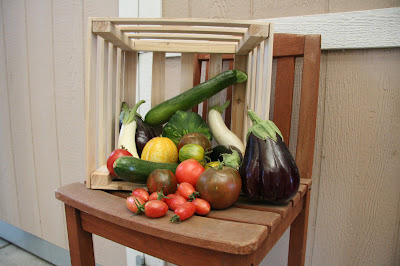 |
| Eggplants and tomatoes are confusing! |
Our post about eggplant a few weeks ago spurred a debate around the office. Is eggplant a fruit or veggie? We all think of it as a vegetable, but the seeds of eggplant are surrounded by the flesh of the edible portion, like apples or watermelon. Isn’t that what most people think makes a fruit a fruit?
Looking it up online warranted even more confusion however, as many sites referred to eggplants as vegetables (which is what most of us call them, right?) but in more formal classifications were referred to as fruit.
So we did what we do whenever we are confused – we turned to food genius (and awesome guy) Harold McGee.
According to Harold's book,
On Food and Cooking: The Science and Lore of the Kitchen, it turns out that the distinction isn’t as clear as some people would think. According to Harold, a vegetable is “essentially…a plant material that is neither fruit nor seed.” Fruit, on the other hand, has both a technical and common definition. According to botanists fruit is “the organ that develops from the flower’s ovary and surrounds the plant’s seeds.” But for culinary or "common" purposes fruits are what we typically think of - apples, peaches, cherries - the sweet things we can eat right off the tree or put into pies. So technically, green beans, eggplants, cucumbers, corn kernels and peppers are fruit. But chefs consider them vegetables. Why is this?
It turns out that this culinary distinction has to do with flavor, which is a result of the basic makeup of the plant. Fruits are engineered to be appealing to animals because it benefits the plant if animals eat the fruits because it helps to disperse the seeds. As Harold says, “they are one of the few things we eat that we’re meant to eat.” They usually have a high sugar content, complex aroma, and they soften themselves; all characteristics which add to their appeal.
On the other hand vegetables are not meant to be eaten, and sometimes even have chemical defenses that are meant to keep animals from consuming them. (Think of the strong flavors and aromas that raw onions and cabbage have!) Vegetables also remain firm and have either a very mild flavor or a very strong one and usually require cooking to make them palatable.
So basically it depends on your intentions for the fruit/veggie. If you are a botanist, a fruit is something completely different than what it is to a chef.
Still not convinced and think that one is more correct than the other? According to
On Food and Cooking, the definition was brought to the attention of the Supreme Court in the 1890s:
“A New York food importer claimed duty-free status for a shipment of tomatoes, arguing that tomatoes were fruit, and so under the regulations of the time, not subject to import fees. The customs agent ruled that tomatoes were vegetables and imposed a duty. A majority of the Supreme Court decided that tomatoes were ‘usually served at a dinner in, with, or after the soup, fish or meat which constitute the principal part of the repast, and not, like fruits, generally as a dessert.’ Ergo tomatoes were vegetables and the importer had to pay.”
The distinction was so difficult to make it had to go all the way to the Supreme Court!
So is eggplant a fruit or a vegetable? It depends – are you a botanist or a chef?
















